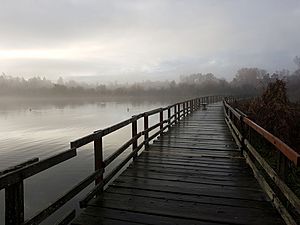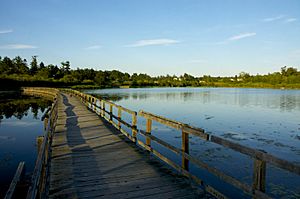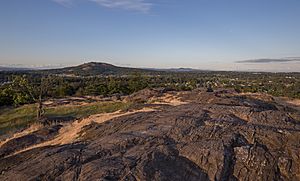Swan Lake Nature Sanctuary facts for kids
Swan Lake Christmas Hill Nature Sanctuary is a nature reserve located in Saanich, British Columbia. The sanctuary includes a lake, adjacent marshy lowlands, and the Nature House, as well as a good part of the summit regions of Christmas Hill.
The nature sanctuary consists of two physically and ecologically distinct areas: the low wetland area surrounding Swan Lake, and the rocky Garry oak-forested hilltop of Christmas Hill. The two areas are joined by a connecting corridor trail along the Nelthorpe Road allowance, crossing McKenzie Avenue at a pedestrian-controlled crosswalk. Portions of the corridor trail are on the roadside, and are identified by signs with a hiker symbol and arrow to indicate the direction.
The sanctuary land surrounding the lake covers 43.4 hectares (107 acres) in addition to the 9.4 hectare (23 acre) lake. In the winter flooding stage, the lake can cover up to 32.4 hectares (80 acres) of the low-lying lands around the lake.
Sanctuary grounds
All of the nature sanctuary lands are owned by Saanich, except for the two parcels identified on the map (Swan lake map, below) as Nature Trust BC Lands, covering 2.4 hectares (6 acres). All of the lands are managed by the Swan Lake Christmas Hill Nature Sanctuary Society under the terms of a land management agreement between the society and the Municipality of Saanich.
- Lake surface area: 9.4 hectares (23 acres)
- Winter flood lake area: 32.4 hectares (80 acres)
- Land area excluding lake: 43.4 hectares (107 acres)
- Land area including lake: 53 hectares (131 acres)
The Swan Lake portion of the nature sanctuary is bordered on the west by the Pat Bay Highway; on the east by Saanich Road; on the north by Ralph Street, Sevenoaks and Nelthorpe; and on the south by the Lockside Regional Trail. On the east side of Saanich Road, the vegetated area under the Lochside trestle is also part of the sanctuary lands. Blenkinsop Creek flows through this area on its way to Swan Lake.
The Christmas Hill portion of the nature sanctuary is bordered on the west by a community greenway trail linking Rainbow Street with Rogers Avenue and Rogers Elementary School, and on the south, east and north by mixed residential lands.
History
Pre-contact human history
First Nations people have lived in coastal B.C. areas for at least 8–9,000 years, though the oldest documented archaeological sites in the Victoria area are about 4,150 years old.
Grant Keddie, Royal BC Museum archaeologist, describes Swan Lake as an important hunting and gathering area for the Songhees people. Over the years, a number of arrowheads and spear tips have been found in the fields and hillsides surrounding the lake, indicating a high level of hunting in the region.
Over a hundred species of plants were known and used by the Songhees for food, medicines and for numerous items used in food gathering and preparation, shelter and ceremony. Important food plants include the Camas lily, wild onion, western crab apple, chocolate lily bulbs, Oregon grape, salmonberry, elderberry, Pacific blackberry, red huckleberry, thimbleberry and fern rhizomes. A variety of cat-tails and swamp rushes were harvested from the lake shore and used in weaving shelters, mats, baskets and clothing.
The lake and streams would have provided a variety of fish, including salmon, rainbow trout, steelhead trout and perch, caught by trolling, jigging, spearing and the placement of wooden basket traps.
All varieties of large birds were hunted and their eggs collected, especially in the winter and during the spring migrations when bird populations soared. Remains of food found in ancient villages show that species of ducks and seagulls represent a large number of the birds consumed. Scoters, grebes, geese, swans, sandhill craness, loons and cormorants, grouse, pigeons, and predator birds such as eagles and hawks were consumed.
Pole nets would have been used extensively at Swan Lake to catch waterfowl. A net stretched between two tall poles would be suddenly raised into the flight path of ducks as they swooped towards the lake in the evening.
Bird parts were used for many things, often related to spiritual or ceremonial use. Women plucked waterfowl and mixed the down with twisted pieces of goose skin and stinging nettle fiber twine to make a textile used for shirts and robes. Bird down was stored in a bag made of swan skin. Feathers were used on masks, headdresses, clothing, and many small ritual objects. Bird skulls, beaks and wings were carried as charms associated with special spirit powers.
Deer would have been plentiful around the lake area, providing an important source of food. Clothing was made from deer hides, and a variety of tools were made from the antlers, including wedges, tool shafts, harpoon, spear and arrow points, awls, chisels, needles, blanket pins, combs, scrapers and fish hook barbs.
The rocky Gary Oak-forested slopes of Christmas hill would likely have been used by the Songhees for the cultivation of the Camas bulb, an important part of the First Nations people's diet. They practiced a wide variety of cultivation techniques, including prescribed burning, to preserve the open landscape favored by the Camas lily. It is thought that the predominance and persistence of Garry oak ecosystems across much of Greater Victoria prior to European settlement was a direct result of centuries of burning and harvesting Camas bulbs.
European settlers
Purchase of land from First Nations
The Songhees people included a tribal group called the Sahsum, or Kosampson. Their village was centered around Craigflower Park and Admirals Road. By 1843, the Kosampson moved to the village of Kala on Esquimalt Harbour, which became part of the Esquimalt Indian Reserve in 1853.
In 1850, the title to the territory deemed to be owned by the Kosampson people was sold to James Douglas of the Hudson's Bay Company.
Origin of names – Swan Lake and Christmas Hill
The origin of Swan Lake's name is not clear. It is listed as such on a map of Victoria in 1885. There is speculation that it was named after James Gilchrist Swan, an American journalist, reservation schoolteacher, lawyer, judge, school superintendent, railroad promoter, natural historian, and ethnographer. Though based in Port Townsend, Swan visited on occasion in the early 1880s.
The more popular belief is that the name refers to the trumpeter swans that would have visited the lake regularly.
Similarly, there are many conflicting reports about the origin of the name Christmas Hill. During the late 1800s and early 1900s, the hill was variously called Lake Hill and Christmas Hill.
One source (Saanich Municipality) indicates that Christmas Hill was named after Hudson's Bay Company factor Joseph William McKay discovered it on Christmas Day in the early 1840s.
Numerous sources recount the legend of Christmas Hill. Purportedly, on Christmas Eve in 1855, a large bird, which was thought to be a Thunderbird by the Lekwungen peoples of the time, swooped down and carried away a small Lekwungen child from the Fort Victoria area. Men from the fort apparently searched until the child was found playing happily on Lake Hill (as Christmas Hill was called then) on December 25. Because of this Christmas miracle, the hill's name was changed.
The names Swan Lake and Christmas Hill were finally officially confirmed by the Geographic Board of Canada on May 1, 1934.
Farming history
Swan Lake and Christmas Hill have a long history of farming, beginning with a sheep farm on the west slopes of Christmas Hill established by Kenneth McKenzie in 1857, and continuing through to the closing of the Pendray dairy farm at Swan Lake in 1978.
An 1885 map of the area shows three land owners, with 100 to 150 acres each:
- John Caspar Von Allman, from the summit of Christmas Hill north
- Kenneth McKenzie, from the summit south to the middle of Swan Lake
- James Stockend, south from the middle of the lake
Little is known about the Von Allman farm, other than a suggestion that it was largely fruit orchards. Vanalman Avenue, just west of the Pat Bay Highway, was named after him.
McKenzie farm
Kenneth McKenzie and his family arrived in Victoria in 1853; he was an employee of the Hudson's Bay Company. While he was developing the Craigflower area, he established a sheep station on Christmas Hill, and subsequently purchased the lands extending from the summit of Christmas Hill to the middle of the lake. In 1866, he moved his family to a newly built home on the west slope of Christmas Hill. He continued to tend his sheep, cattle and horses, and raise vegetables until his death in April 1874. In April 1884, the property was subdivided into 110 lots of 5 acres each, and sold for $110/acre. Kenneth's daughters, Agnes and Wilhemena, lived in the farmhouse until their deaths in 1928 and 1929, respectively.
Rogers farm
George Rogers Senior came to Victoria in 1886, and worked as a tenant farmer. He leased, and later purchased, in 1903, the Von Allman farm on the north side of the hill. At first it was known as the Alderlea Farm, but because another farmer claimed prior use of the name, Rogers renamed his farm Chesterlea. George Junior took over his father's duties, and in 1925 he constructed his family house on Rogers Avenue. At this time the dairy farm was 91 hectares (225 acres).
A portion of the Rogers farm is now occupied by Rogers Elementary School. A large portion of the farm was sold to Saanich for the nature sanctuary, and a small part of the farm was subdivided for residential development. The Rogers family's role in this area is commemorated in the nearby road names - Rogers Avenue, Lily Avenue (George Senior's wife), Genevieve Road (George Junior's wife) and Chesterlea Road.
Pendray dairy farm
One of the first major parcels of land around the lake that was purchased for the nature sanctuary was the 12-hectare Pendray farm, on the east side of the lake. Joel Pendray began operating the dairy farm there in 1917. His son Tom continued after Joel's death in 1954. This was the last dairy in Victoria to sell raw (unpasteurized) milk. The farm was in operation until March 1978 when the land was turned over to the nature sanctuary.
Girling farm
In October 1912, the Girling family established a small hobby farm at Swan Lake, between Ralph Street and the lake, bordered by Lancaster Road to the west. Anne Alice Girling, one of the daughters, had studied photography in England before they came to Victoria, and left a treasure of photographs at Swan Lake and Christmas Hill in the early 1900s. Her collection has been preserved and stored at the Saanich Archives.
Swan Lake Hotel
The Swan Lake Hotel was located on the south side of the lake in 1864, on Saanich Road opposite Falmouth, directly above the south wharf. The hotel was reputed to be excellent for fishing, spring and summer, and perfect for ice skating in the winter. This was Saanich's first year-round recreational resort. In January 1894, the hotel burned to the ground. As it was a popular and successful resort, it was quickly rebuilt. It burned to the ground again in October 1897, with the occupants barely escaping with their lives. However, it was never rebuilt after the 1897 mishap.
Swan Lake Christmas Hill Nature House
The Nature House is open seven days a week, and admission is by donation. It contains a library, a bee colony, offices, a classroom, nature exhibits, two snakes, and a turtle. Classroom space is available for rent after opening hours, and many community events are hosted there.
Boardwalks and trails
The sanctuary has a total of 3.75 km of trails, consisting of 2.5 kilometres of gravel-surfaced loop trail around Swan Lake and 1.25 km in the Christmas Hill portion of the sanctuary. There are two wharves, several wooden bridges, and a boardwalk across one end of the lake.
The wharves and floating boardwalk were originally built by members of the Canadian military. The floating boardwalk offered an unprecedented level of access to the lake water, a facility unique in the Capital Region. It quickly became the focus of many of the education programs, providing opportunities for bird-watching and lake water studies. The original floating boardwalk was in place until 2018, when it was decided that in order to accommodate the winter water levels in the lake and keep visitors safe, a new, longer boardwalk was to be constructed in two phases. The new boardwalk was unveiled in October 2018 to a fanfare of community support.
Native plant garden
A native plant garden was completed near the nature house in 1998, after four years of work. The garden houses 70 types of flowers and shrubs, all native to Southern Vancouver Island, and includes stone steps leading up to the nature house, a drip fountain, several benches, and a hidden area with bird feeders. The native plant garden was specially designed to keep the plant species hydrated.
Rules and regulations for the sanctuary
Some regulations governing activities and behaviors arise from Board policy, and some are under municipal bylaw authority.
Saanich Bylaws:
1) Dog Bylaw (Regulation of Animals Bylaw No. 8556)
Because of the designation of the Swan Lake Sanctuary space as a migrating bird refuge, no dogs are permitted on any of the trails surrounding the lake.
2) Bike Bylaw (Parks Management and Control Bylaw, No. 7753
Due to the narrow and rocky nature of the trails, bikes are not permitted on the trails around the lake area, except for in the parking lot or paved roadway.
The Sanctuary Board policies for land use also prohibit recreational boating, fishing and swimming in the lake.





